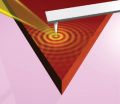(Press-News.org) SEATTLE – A simple questionnaire that rates breathing difficulties on a scale of 0 to 3 predicts survival in chronic graft-vs.-host disease, according to a study published in the March issue of Biology of Blood and Marrow Transplantation.
And although a poor score means a higher risk of death, asking a simple question that can spot lung involvement early means that patients can begin treatments to reduce or manage symptoms, said senior author Stephanie Lee, M.D., M.P.H., research director of Fred Hutchinson Cancer Research Center's Long-Term Follow-Up Program, member of the Clinical Research Division at Fred Hutch and professor of oncology at the University of Washington School of Medicine.
"It's a warning," said Lee, senior author of the study. "It puts us on notice to be more careful and attentive."
GVHD is an immune reaction that occurs in some patients who have received bone marrow or blood cell transplants using donor cells. In GVHD, the transplanted cells — which will become the patient's new immune system — attack the patient's own cells as they would a foreign object or infection. GVHD can be either acute or chronic; severe, uncontrolled cases can be fatal.
Chronic GVHD most often involves the skin and mouth, but almost any other organ system can be involved. The likelihood of developing chronic GVHD is around 30 to 50 percent, said Lee. Of those who do develop it, about 15 to 20 percent will have lung involvement.
In 2005, the National Institutes of Health recommended assessment of lung function in patients with chronic GVHD using both pulmonary function tests — machines that measure air flow — and an assessment of symptoms.
The newly published study found that shortness of breath is associated with a higher risk of death overall and of nonrelapse mortality, and that worsening symptoms over time were associated with increased mortality. Researchers analyzed a total of 1,591 visits by 496 patients in multiple treatment centers.
One of the study's findings was both surprising and encouraging: As a screening test, the simple questionnaire outperformed other tests, which the study called encouraging.
"The questionnaire turned out to be the most predictive," Lee said. "It's just a question, therefore easy to do and cost effective. No special equipment is involved."
The NIH symptom-based lung score asks about breathing difficulties and assigns the following numbers: 0 for no symptoms, 1 for shortness of breath with stairs, 2 for shortness of breath on flat ground, and 3 for shortness of breath at rest or requiring oxygen.
Not surprisingly, a score of 3 (shortness of breath at rest or requiring oxygen) was associated with higher mortality. But, the study pointed out, even patients with an NIH symptom-based lung score of 1 (shortness of breath with stairs) had a worse outcome than those with a score of 0.
Again, Lee saw the result as a way to notice problems earlier and start treatment sooner.
The patient's doctor would most likely follow up a poor score with other tests, such as a CT scan, to determine the cause; although chronic GVHD should always be suspected following a transplant, it is not the cause of every problem. The first line of treatment for chronic GVHD is medicines that suppress the immune system.
A poor score can also serve as a reminder to make sure the patient has had a pneumonia vaccination and is taking other precautions, Lee said.
INFORMATION:
The Fred Hutch Long-Term Follow-Up program is a lifelong monitoring and care program for bone marrow and stem cell transplant survivors.
The National Institutes of Health funded the research, which also involved researchers at the Medical College of Wisconsin, Children's National Medical Center, Dana-Farber Cancer Institute, University of Minnesota, University of Pittsburgh, Moffitt Cancer Center, the National Institues of Health, Lineberger Comprehensive Cancer Center, Stanford University, Vanderbilt University and Johns Hopkins Hospital.
Editor's note: This news release was written by Fred Hutch staff writer/editor Mary Engel. To obtain a copy of the Biology of Blood and Marrow Transplantation paper, Pulmonary Symptoms Measured by the National Institutes of Health Lung Score Predict Overall Survival, Nonrelapse Mortality, and Patient-Reported Outcomes in Chronic Graft-Versus-Host Disease, or to arrange an interview with senior author Stephanie Lee, M.D., M.P.H., contact Kristen Woodward, media@fredhutch.org or 206-667-2210.
At Fred Hutchinson Cancer Research Center, home to three Nobel laureates, interdisciplinary teams of world-renowned scientists seek new and innovative ways to prevent, diagnose and treat cancer, HIV/AIDS and other life-threatening diseases. Fred Hutch's pioneering work in bone marrow transplantation led to the development of immunotherapy, which harnesses the power of the immune system to treat cancer with minimal side effects. An independent, nonprofit research institute based in Seattle, Fred Hutch houses the nation's first and largest cancer prevention research program, as well as the clinical coordinating center of the Women's Health Initiative and the international headquarters of the HIV Vaccine Trials Network. Private contributions are essential for enabling Fred Hutch scientists to explore novel research opportunities that lead to important medical breakthroughs. For more information visit http://www.fredhutch.org or follow Fred Hutch on Facebook, Twitter or YouTube.
Early detection helps manage a chronic graft-vs.-host disease complication
Simple, cost-effective questionnaire outperforms other tests in spotting lung involvement
2014-03-06
ELSE PRESS RELEASES FROM THIS DATE:
Crashing comets explain surprise gas clump around young star
2014-03-06
Beta Pictoris, a nearby star easily visible to the naked eye in the southern sky, is already hailed as the archetypal young planetary system. It is known to harbour a planet that orbits some 1.2 billion kilometres from the star, and it was one of the first stars found to be surrounded by a large disc of dusty debris [1].
New observations from ALMA now show that the disc is permeated by carbon monoxide gas.
Paradoxically the presence of carbon monoxide, which is so harmful to humans on Earth, could indicate that the Beta Pictoris planetary system may eventually become ...
ALMA sees icy wreckage in nearby solar system
2014-03-06
Astronomers using the Atacama Large Millimeter/submillimeter Array (ALMA) telescope have discovered the splattered remains of comets colliding together around a nearby star; the researchers believe they are witnessing the total destruction of one of these icy bodies once every five minutes.
The "smoking gun" implicating this frosty demolition is the detection of a surprisingly compact region of carbon monoxide (CO) gas swirling around the young, nearby star Beta Pictoris.
"Molecules of CO can survive around a star for only a brief time, about 100 years, before being ...
Galactic gas caused by colliding comets suggests mystery 'shepherd' exoplanet
2014-03-06
Astronomers exploring the disk of debris around the young star Beta Pictoris have discovered a compact cloud of carbon monoxide located about 8 billion miles (13 billion kilometers) from the star. This concentration of poisonous gas – usually destroyed by starlight – is being constantly replenished by ongoing rapid-fire collisions among a swarm of icy, comet-like bodies.
In fact, to offset the destruction of carbon monoxide (CO) molecules around the star, a large comet must be getting completely destroyed every five minutes, say researchers.
They suggest the comet swarm ...
Vitamin D increases breast cancer patient survival
2014-03-06
Breast cancer patients with high levels of vitamin D in their blood are twice as likely to survive the disease as women with low levels of this nutrient, report University of California, San Diego School of Medicine researchers in the March issue of Anticancer Research.
In previous studies, Cedric F. Garland, DrPH, professor in the Department of Family and Preventive Medicine, showed that low vitamin D levels were linked to a high risk of premenopausal breast cancer. That finding, he said, prompted him to question the relationship between 25-hydroxyvitamin D — a metabolite ...
UT Arlington study links BPA and breast cancer tumor growth
2014-03-06
UT Arlington biochemists say their newly published study brings researchers a step closer to understanding how the commonly used synthetic compound bisphenol-A, or BPA, may promote breast cancer growth.
Subhrangsu Mandal, associate professor of chemistry/biochemistry, and Arunoday Bhan, a PhD student in Mandal's lab, looked at a molecule called RNA HOTAIR. HOTAIR is an abbreviation for long, non-coding RNA, a part of DNA in humans and other vertebrates. HOTAIR does not produce a protein on its own but, when it is being expressed or functioning, it can suppress genes that ...
NASA's TRMM satellite images show California soaker moved eastward
2014-03-06
The Tropical Rainfall Measuring Mission or TRMM satellite provided a look at the rainfall associated with the large storm system that brought soaking rains to California on Feb. 28 and Mar. 1. Satellite imagery created at NASA shows the movement of the storm from the U.S. West Coast to the East Coast.
At NASA's Goddard Space Flight Center in Greenbelt, Md. images were created using data from the TRMM Microwave Imager (TMI) instrument that showed the movement of recent stormy weather from California's Pacific Ocean coast to the Atlantic Coast. TRMM is a satellite managed ...
NASA's THEMIS discovers new process that protects Earth from space weather
2014-03-06
In the giant system that connects Earth to the sun, one key event happens over and over: solar material streams toward Earth and the giant magnetic bubble around Earth, the magnetosphere helps keep it at bay. The parameters, however, change: The particles streaming in could be from the constant solar wind, or perhaps from a giant cloud erupting off the sun called a coronal mass ejection, or CME. Sometimes the configuration is such that the magnetosphere blocks almost all the material, other times the connection is long and strong, allowing much material in. Understanding ...
Crystals ripple in response to light
2014-03-06
Light can trigger coordinated, wavelike motions of atoms in atom-thin layers of crystal, scientists have shown. The waves, called phonon polaritons, are far shorter than light waves and can be "tuned" to particular frequencies and amplitudes by varying the number of layers of crystal, they report in the early online edition of Science March 7.
These properties - observed in this class of material for the first time - open the possibility of using polaritons to convey information in tight spaces, create images at far finer resolution than is possible with light, and manage ...
Plasma plumes help shield Earth from damaging solar storms
2014-03-06
The Earth's magnetic field, or magnetosphere, stretches from the planet's core out into space, where it meets the solar wind, a stream of charged particles emitted by the sun. For the most part, the magnetosphere acts as a shield to protect the Earth from this high-energy solar activity.
But when this field comes into contact with the sun's magnetic field — a process called "magnetic reconnection" — powerful electrical currents from the sun can stream into Earth's atmosphere, whipping up geomagnetic storms and space weather phenomena that can affect high-altitude aircraft, ...
Researchers calculate how river networks move across a landscape
2014-03-06
Large river networks — such as those that funnel into the Colorado and Mississippi rivers — may seem to be permanent features of a landscape. In fact, many rivers define political boundaries that have been in place for centuries.
But scientists have long suspected that river networks are not as static as they may appear, and have gathered geologic and biological evidence that suggest many rivers have been "rewired," shifting and moving across a landscape over millions of years.
Now researchers at MIT and the Swiss Federal Institute of Technology (ETH Zurich) have developed ...
LAST 30 PRESS RELEASES:
For teens, any cannabis use may have impact on emotional health, academic performance
School meals could unlock major gains for human and planetary health
Menopause hormone therapy does not appear to impact dementia risk
Signature patterns of brain activity may help predict recovery from traumatic brain injury
Dresden study uncovers new key mechanism in cancer cells
New species are now being discovered faster than ever before, study suggests
Cannabis-based products show limited short-term benefit for chronic pain, with increased risk of adverse effects
Cannabis products with more THC slightly reduce pain but cause more side effects
Clearing the brain of aging cells could aid epilepsy and reduce seizures
Brain injuries linked with potential risk of suicide, new study finds
New technique lights up where drugs go in the body, cell by cell
New study finds movement of fishing fleets can reveal shifts in marine ecosystems
Embargoed: New evidence points to potential treatment for vascular dementia
Study uncovers disrupted brain balance in alcohol dependence
Working in groups can help Republicans and Democrats agree on controversial content moderation online
Structural findings reveal how distinct GPCR ligands create different levels of activation
Anything-goes “anyons” may be at the root of surprising quantum experiments
UC review: Maximizing workplace opportunity for veterans
From generation to complex control: Metasurfaces make perfect vortex beams "within reach"
Thin-film lithium niobate-based detector: recent advances and perspectives
Exploring why some people may tend to persistently make bad choices
How cells balance their protein levels
Nirsevimab vs RSVpreF vaccine for RSV–related hospitalization in newborns
Effectiveness and impact of maternal RSV immunization and nirsevimab on medically attended RSV in US children
AI gives scientists a boost, but at the cost of too many mediocre papers
Next-generation vision model maps tree growth at sub-meter precision
Genes aren’t destiny for inherited blindness, study shows
MIT study: High-fat diets make liver cells more likely to become cancerous
Exposure to multiple fine particulate matter components and incident depression in the US Medicare population
Risk of burdensome health care spending over time in the US
[Press-News.org] Early detection helps manage a chronic graft-vs.-host disease complicationSimple, cost-effective questionnaire outperforms other tests in spotting lung involvement







